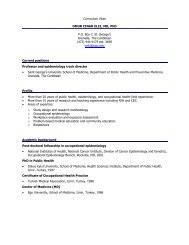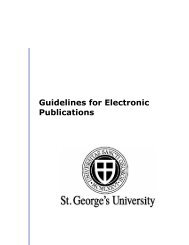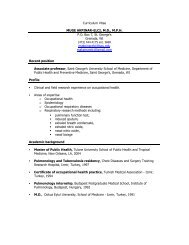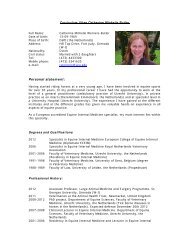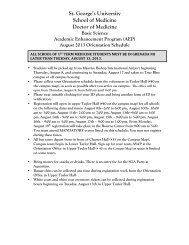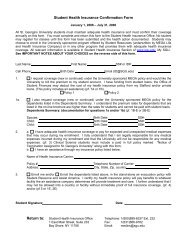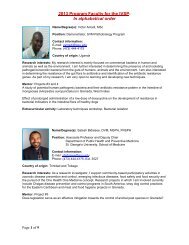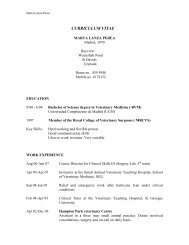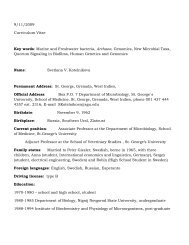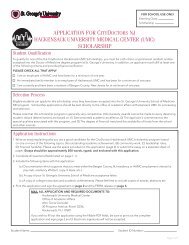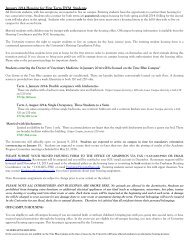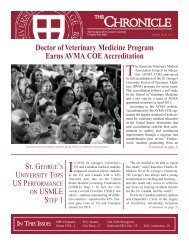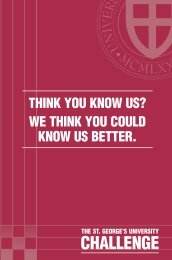SCHOOL OF 2012-2013 - St. George's University
SCHOOL OF 2012-2013 - St. George's University
SCHOOL OF 2012-2013 - St. George's University
You also want an ePaper? Increase the reach of your titles
YUMPU automatically turns print PDFs into web optimized ePapers that Google loves.
School of Medicine<br />
Course Descriptions<br />
on the <strong>University</strong> website and made available to students.<br />
Periodically, gross specimens and glass slides from current<br />
hospital material are also discussed. The discussions are<br />
closely monitored by the faculty and students are evaluated<br />
on a daily basis.<br />
The general pathology segment deals with how tissues<br />
respond to injury, cell death, inflammation, ischemia,<br />
thrombosis, embolism, infarction, and so forth. It also deals<br />
with response to infections, environmental pollutants, and<br />
disease states related to abnormal immune responses.<br />
Mechanisms of tumor development and how tumors<br />
spread are studied under “neoplasia.” This is followed by<br />
a special course on molecular pathology techniques as<br />
applied to clinical practice.<br />
The systemic pathology segment involves similar principles<br />
but applied in detail to individual organ systems like<br />
cardiovascular, respiratory, and so forth. It will also include<br />
interpretation of laboratory data for some of the major<br />
disease processes. A short course on forensic pathology<br />
is taught in the systemic pathology module. Several<br />
clinicopathological conferences, including difficult case<br />
seminars, are also discussed by students.<br />
<strong>St</strong>udents are mandated to draw concept maps each week<br />
and submit them for evaluation. All the questions are<br />
clinical problem-solving MCQs.<br />
• Laboratory<br />
The lab sessions are conducted as group activities in<br />
student groups of 10 to 12 monitored by a clinical tutor.<br />
The students discuss gross and microscopic pathology<br />
images, electron micrographs, radiographic images, and<br />
clinical cases, which correlate with the concurrent lecture<br />
manual. The process involves active learning with guided<br />
discovery of etiology, pathogenesis, structural changes,<br />
clinical symptoms and signs, relevant investigations, and<br />
course of the disease for the common and prototype<br />
diseases. The students are also encouraged to learn how<br />
to distinguish between related entities.<br />
PATH 693<br />
Medical Nutrition<br />
Medical Nutrition focuses on the relevance of nutrition in<br />
the prevention and treatment of disease. Presented in this<br />
course are those components of human pathophysiology<br />
in which diet on the basis of current knowledge is believed<br />
to be important in either a causative or contributory way.<br />
The application of dietary knowledge to prevention of<br />
disease and the management of established disease are<br />
also discussed. Also addressed are clinical topics such<br />
as infant, maternal, and geriatric nutrition; problems of<br />
obesity and related subjects; and the principles of the<br />
management of diseases such as diabetes mellitus, renal<br />
failure, and atherosclerosis.<br />
Pathophysiology<br />
Subramanya Upadhya, MBBS, MD, DNB, Chair<br />
PATH 674<br />
Pathophysiology<br />
The Pathophysiology course aims to provide a platform<br />
for active learning where the students learn to analyze a<br />
clinical problem starting with presenting symptoms and<br />
logically develop an algorithm for the analysis of physical<br />
signs, investigations, identification of the disease process,<br />
distinguishing from other related entities, deciding on<br />
the course of illness, principles of initial management and<br />
explaining all these on the important concepts of basic<br />
sciences learnt from the previous courses in the medical<br />
school. By presenting the course concomitantly with<br />
Pharmacology and Introduction to Clinical Medicine in an<br />
integrated fashion, the goals and objectives of the course<br />
are achieved. This integration is further strengthened by<br />
the presentation of the “cases in small groups”. The cases<br />
are prepared by the department faculty with the assistance<br />
of visiting professors. <strong>St</strong>udents meet in small groups<br />
to discuss specific questions relative to each case. The<br />
lectures include discussions on several clinical vignettes,<br />
which provide a basis for exploring the basic science<br />
concepts to explain symptoms, signs, investigations, and<br />
complications. In addition, about 50 USMLE <strong>St</strong>ep 1-type<br />
questions are provided online as practice test that covers<br />
the learning objectives on the topics of every week.<br />
The course is taught in organ/system based approach. An<br />
organ systems (cardiology, pulmonology, gastroenterology,<br />
nephrology, hematology, endocrinology, dermatology,<br />
and neurology) and interdisciplinary (clinical immunology,<br />
rheumatology, infectious diseases, psychiatry, pediatrics,<br />
obstetrics and gynecology, sexuality, clinical nutrition, and<br />
oncology) approach is used. Lectures are delivered by<br />
visiting professors or full-time faculty who are outstanding<br />
clinicians/academicians in their fields. These lectures<br />
62 | <strong>St</strong>. George’s <strong>University</strong>



